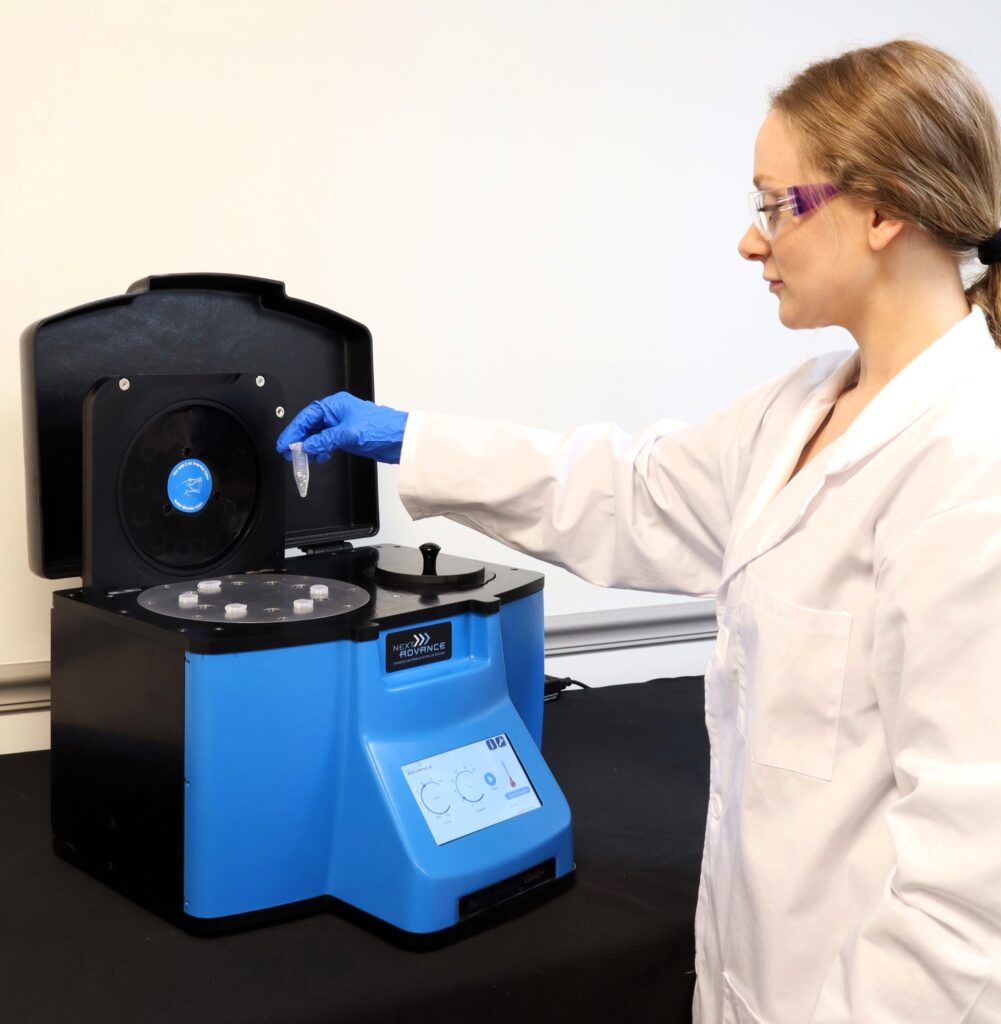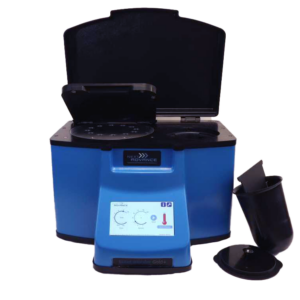Ideal for Bacteria Homogenization
Do you spend lots of time and effort homogenizing bacteria samples? The Bullet Blender® tissue homogenizer delivers high quality and superior yields. No other homogenizer comes close to delivering the Bullet Blender’s winning combination of top-quality performance and budget-friendly affordability. See below for a bacteria homogenization protocol.
Save Time, Effort and Get Superior Results with
The Bullet Blender Homogenizer
Consistent and High Yield Results
Run up to 24 samples at the same time under microprocessor-controlled conditions, ensuring experimental reproducibility and high yield. Process samples from 10mg or less up to 3.5g.No Cross Contamination
No part of the Bullet Blender ever touches the tissue – the sample tubes are kept closed during homogenization. There are no probes to clean between samples.Samples Stay Cool
The Bullet Blenders’ innovative and elegant design provides convective cooling of the samples, so they do not heat up more than several degrees. In fact, our Gold+ models hold the sample temperature to about 4ºC.Easy and Convenient to Use
Just place beads and buffer along with your tissue sample in standard tubes, load tubes directly in the Bullet Blender, select time and speed, and press start.Risk Free Purchase
Thousands of peer-reviewed journal articles attest to the consistency and quality of the Bullet Blender homogenizer. We offer a 2 year warranty, extendable to 4 years, because our Bullet Blenders are reliable and last for many years.Bacteria Homogenization Protocol
Sample size |
See the Protocol |
| microcentrifuge tube model (up to 300 mg) | Small bacteria samples |
| 5mL tube model (100mg - 1g) | Medium bacteria samples |
| 50mL tube model (100mg - 3.5g) | Large bacteria samples |
What Else Can You Homogenize? Tough or Soft, No Problem!
The Bullet Blender can process a wide range of samples including organ tissue, cell culture, plant tissue, and small organisms. You can homogenize samples as tough as mouse femur or for gentle applications such as tissue dissociation or organelle isolation.

Want more guidance? Need a quote? Contact us:

Bullet Blender Models
Select Publications using the Bullet Blender to Homogenize Bacteria
2474232
bacteria
1
apa
50
date
desc
3078
https://www.nextadvance.com/wp-content/plugins/zotpress/
%7B%22status%22%3A%22success%22%2C%22updateneeded%22%3Afalse%2C%22instance%22%3Afalse%2C%22meta%22%3A%7B%22request_last%22%3A0%2C%22request_next%22%3A0%2C%22used_cache%22%3Atrue%7D%2C%22data%22%3A%5B%7B%22key%22%3A%229JJ3497P%22%2C%22library%22%3A%7B%22id%22%3A2474232%7D%2C%22meta%22%3A%7B%22creatorSummary%22%3A%22Otwell%20et%20al.%22%2C%22parsedDate%22%3A%222016-02-19%22%2C%22numChildren%22%3A2%7D%2C%22bib%22%3A%22%26lt%3Bdiv%20class%3D%26quot%3Bcsl-bib-body%26quot%3B%20style%3D%26quot%3Bline-height%3A%202%3B%20padding-left%3A%201em%3B%20text-indent%3A-1em%3B%26quot%3B%26gt%3B%5Cn%20%20%26lt%3Bdiv%20class%3D%26quot%3Bcsl-entry%26quot%3B%26gt%3BOtwell%2C%20A.%20E.%2C%20Callister%2C%20S.%20J.%2C%20Zink%2C%20E.%20M.%2C%20Smith%2C%20R.%20D.%2C%20%26amp%3B%20Richardson%2C%20R.%20E.%20%282016%29.%20Comparative%20Proteomic%20Analysis%20of%20Desulfotomaculum%20reducens%20MI-1%3A%20Insights%20into%20the%20Metabolic%20Versatility%20of%20a%20Gram-Positive%20Sulfate-%20and%20Metal-Reducing%20Bacterium.%20%26lt%3Bi%26gt%3BFrontiers%20in%20Microbiology%26lt%3B%5C%2Fi%26gt%3B%2C%20%26lt%3Bi%26gt%3B7%26lt%3B%5C%2Fi%26gt%3B.%20%26lt%3Ba%20class%3D%26%23039%3Bzp-DOIURL%26%23039%3B%20href%3D%26%23039%3Bhttps%3A%5C%2F%5C%2Fdoi.org%5C%2F10.3389%5C%2Ffmicb.2016.00191%26%23039%3B%26gt%3Bhttps%3A%5C%2F%5C%2Fdoi.org%5C%2F10.3389%5C%2Ffmicb.2016.00191%26lt%3B%5C%2Fa%26gt%3B%26lt%3B%5C%2Fdiv%26gt%3B%5Cn%26lt%3B%5C%2Fdiv%26gt%3B%22%2C%22data%22%3A%7B%22itemType%22%3A%22journalArticle%22%2C%22title%22%3A%22Comparative%20Proteomic%20Analysis%20of%20Desulfotomaculum%20reducens%20MI-1%3A%20Insights%20into%20the%20Metabolic%20Versatility%20of%20a%20Gram-Positive%20Sulfate-%20and%20Metal-Reducing%20Bacterium%22%2C%22creators%22%3A%5B%7B%22creatorType%22%3A%22author%22%2C%22firstName%22%3A%22Anne%20E.%22%2C%22lastName%22%3A%22Otwell%22%7D%2C%7B%22creatorType%22%3A%22author%22%2C%22firstName%22%3A%22Stephen%20J.%22%2C%22lastName%22%3A%22Callister%22%7D%2C%7B%22creatorType%22%3A%22author%22%2C%22firstName%22%3A%22Erika%20M.%22%2C%22lastName%22%3A%22Zink%22%7D%2C%7B%22creatorType%22%3A%22author%22%2C%22firstName%22%3A%22Richard%20D.%22%2C%22lastName%22%3A%22Smith%22%7D%2C%7B%22creatorType%22%3A%22author%22%2C%22firstName%22%3A%22Ruth%20E.%22%2C%22lastName%22%3A%22Richardson%22%7D%5D%2C%22abstractNote%22%3A%22The%20proteomes%20of%20the%20metabolically%20versatile%20and%20poorly%20characterized%20Gram-positive%20bacterium%20Desulfotomaculum%20reducens%20MI-1%20were%20compared%20across%20four%20cultivation%20conditions%20including%20sulfate%20reduction%2C%20soluble%20Fe%28III%29%20reduction%2C%20insoluble%20Fe%28III%29%20reduction%2C%20and%20pyruvate%20fermentation.%20Collectively%20across%20conditions%2C%20we%20observed%20at%20high%20confidence%20~38%25%20of%20genome-encoded%20proteins.%20Here%2C%20we%20focus%20on%20proteins%20that%20display%20significant%20differential%20abundance%20on%20conditions%20tested.%20To%20the%20best%20of%20our%20knowledge%2C%20this%20is%20the%20first%20full-proteome%20study%20focused%20on%20a%20Gram-positive%20organism%20cultivated%20either%20on%20sulfate%20or%20metal-reducing%20conditions.%20Several%20proteins%20with%20uncharacterized%20function%20encoded%20within%20heterodisulfide%20reductase%20%28hdr%29-containing%20loci%20were%20upregulated%20on%20either%20sulfate%20%28Dred_0633-4%2C%20Dred_0689-90%2C%20and%20Dred_1325-30%29%20or%20Fe%28III%29-citrate-reducing%20conditions%20%28Dred_0432-3%20and%20Dred_1778-84%29.%20Two%20of%20these%20hdr-containing%20loci%20display%20homology%20to%20recently%20described%20flavin-based%20electron%20bifurcation%20%28FBEB%29%20pathways%20%28Dred_1325-30%20and%20Dred_1778-84%29.%20Additionally%2C%20we%20propose%20that%20a%20cluster%20of%20proteins%2C%20which%20is%20homologous%20to%20a%20described%20FBEB%20lactate%20dehydrogenase%20%28LDH%29%20complex%2C%20is%20performing%20lactate%20oxidation%20in%20D.%20reducens%20%28Dred_0367-9%29.%20Analysis%20of%20the%20putative%20sulfate%20reduction%20machinery%20in%20D.%20reducens%20revealed%20that%20most%20of%20these%20proteins%20are%20constitutively%20expressed%20across%20cultivation%20conditions%20tested.%20In%20addition%2C%20peptides%20from%20the%20single%20multiheme%20c-type%20cytochrome%20%28MHC%29%20in%20the%20genome%20were%20exclusively%20observed%20on%20the%20insoluble%20Fe%28III%29%20condition%2C%20suggesting%20that%20this%20MHC%20may%20play%20a%20role%20in%20reduction%20of%20insoluble%20metals.%22%2C%22date%22%3A%222016-2-19%22%2C%22language%22%3A%22%22%2C%22DOI%22%3A%2210.3389%5C%2Ffmicb.2016.00191%22%2C%22ISSN%22%3A%221664-302X%22%2C%22url%22%3A%22http%3A%5C%2F%5C%2Fwww.ncbi.nlm.nih.gov%5C%2Fpmc%5C%2Farticles%5C%2FPMC4759654%5C%2F%22%2C%22collections%22%3A%5B%22M2MNG549%22%5D%2C%22dateModified%22%3A%222016-06-10T19%3A15%3A03Z%22%7D%7D%2C%7B%22key%22%3A%22Z6BDJ8EQ%22%2C%22library%22%3A%7B%22id%22%3A2474232%7D%2C%22meta%22%3A%7B%22creatorSummary%22%3A%22Tranchemontagne%20et%20al.%22%2C%22parsedDate%22%3A%222016%22%2C%22numChildren%22%3A0%7D%2C%22bib%22%3A%22%26lt%3Bdiv%20class%3D%26quot%3Bcsl-bib-body%26quot%3B%20style%3D%26quot%3Bline-height%3A%202%3B%20padding-left%3A%201em%3B%20text-indent%3A-1em%3B%26quot%3B%26gt%3B%5Cn%20%20%26lt%3Bdiv%20class%3D%26quot%3Bcsl-entry%26quot%3B%26gt%3BTranchemontagne%2C%20Z.%20R.%2C%20Camire%2C%20R.%20B.%2C%20O%26%23x2019%3BDonnell%2C%20V.%20J.%2C%20Baugh%2C%20J.%2C%20%26amp%3B%20Burkholder%2C%20K.%20M.%20%282016%29.%20Staphylococcus%20aureus%20Strain%20USA300%20Perturbs%20Acquisition%20of%20Lysosomal%20Enzymes%20and%20Requires%20Phagosomal%20Acidification%20for%20Survival%20inside%20Macrophages.%20%26lt%3Bi%26gt%3BInfection%20and%20Immunity%26lt%3B%5C%2Fi%26gt%3B%2C%20%26lt%3Bi%26gt%3B84%26lt%3B%5C%2Fi%26gt%3B%281%29%2C%20241%26%23x2013%3B253.%20%26lt%3Ba%20class%3D%26%23039%3Bzp-DOIURL%26%23039%3B%20href%3D%26%23039%3Bhttps%3A%5C%2F%5C%2Fdoi.org%5C%2F10.1128%5C%2FIAI.00704-15%26%23039%3B%26gt%3Bhttps%3A%5C%2F%5C%2Fdoi.org%5C%2F10.1128%5C%2FIAI.00704-15%26lt%3B%5C%2Fa%26gt%3B%26lt%3B%5C%2Fdiv%26gt%3B%5Cn%26lt%3B%5C%2Fdiv%26gt%3B%22%2C%22data%22%3A%7B%22itemType%22%3A%22journalArticle%22%2C%22title%22%3A%22Staphylococcus%20aureus%20Strain%20USA300%20Perturbs%20Acquisition%20of%20Lysosomal%20Enzymes%20and%20Requires%20Phagosomal%20Acidification%20for%20Survival%20inside%20Macrophages%22%2C%22creators%22%3A%5B%7B%22creatorType%22%3A%22author%22%2C%22firstName%22%3A%22Zachary%20R.%22%2C%22lastName%22%3A%22Tranchemontagne%22%7D%2C%7B%22creatorType%22%3A%22author%22%2C%22firstName%22%3A%22Ryan%20B.%22%2C%22lastName%22%3A%22Camire%22%7D%2C%7B%22creatorType%22%3A%22author%22%2C%22firstName%22%3A%22Vanessa%20J.%22%2C%22lastName%22%3A%22O%27Donnell%22%7D%2C%7B%22creatorType%22%3A%22author%22%2C%22firstName%22%3A%22Jessfor%22%2C%22lastName%22%3A%22Baugh%22%7D%2C%7B%22creatorType%22%3A%22author%22%2C%22firstName%22%3A%22Kristin%20M.%22%2C%22lastName%22%3A%22Burkholder%22%7D%2C%7B%22creatorType%22%3A%22editor%22%2C%22firstName%22%3A%22C.%20R.%22%2C%22lastName%22%3A%22Roy%22%7D%5D%2C%22abstractNote%22%3A%22%22%2C%22date%22%3A%2201%5C%2F2016%22%2C%22language%22%3A%22en%22%2C%22DOI%22%3A%2210.1128%5C%2FIAI.00704-15%22%2C%22ISSN%22%3A%220019-9567%2C%201098-5522%22%2C%22url%22%3A%22http%3A%5C%2F%5C%2Fiai.asm.org%5C%2Flookup%5C%2Fdoi%5C%2F10.1128%5C%2FIAI.00704-15%22%2C%22collections%22%3A%5B%22M2MNG549%22%5D%2C%22dateModified%22%3A%222015-12-31T19%3A49%3A06Z%22%7D%7D%2C%7B%22key%22%3A%22EH35A4UE%22%2C%22library%22%3A%7B%22id%22%3A2474232%7D%2C%22meta%22%3A%7B%22creatorSummary%22%3A%22Wilde%20et%20al.%22%2C%22parsedDate%22%3A%222015-12-18%22%2C%22numChildren%22%3A0%7D%2C%22bib%22%3A%22%26lt%3Bdiv%20class%3D%26quot%3Bcsl-bib-body%26quot%3B%20style%3D%26quot%3Bline-height%3A%202%3B%20padding-left%3A%201em%3B%20text-indent%3A-1em%3B%26quot%3B%26gt%3B%5Cn%20%20%26lt%3Bdiv%20class%3D%26quot%3Bcsl-entry%26quot%3B%26gt%3BWilde%2C%20A.%20D.%2C%20Snyder%2C%20D.%20J.%2C%20Putnam%2C%20N.%20E.%2C%20Valentino%2C%20M.%20D.%2C%20Hammer%2C%20N.%20D.%2C%20Lonergan%2C%20Z.%20R.%2C%20Hinger%2C%20S.%20A.%2C%20Aysanoa%2C%20E.%20E.%2C%20Blanchard%2C%20C.%2C%20Dunman%2C%20P.%20M.%2C%20Wasserman%2C%20G.%20A.%2C%20Chen%2C%20J.%2C%20Shopsin%2C%20B.%2C%20Gilmore%2C%20M.%20S.%2C%20Skaar%2C%20E.%20P.%2C%20%26amp%3B%20Cassat%2C%20J.%20E.%20%282015%29.%20Bacterial%20Hypoxic%20Responses%20Revealed%20as%20Critical%20Determinants%20of%20the%20Host-Pathogen%20Outcome%20by%20TnSeq%20Analysis%20of%20Staphylococcus%20aureus%20Invasive%20Infection.%20%26lt%3Bi%26gt%3BPLOS%20Pathogens%26lt%3B%5C%2Fi%26gt%3B%2C%20%26lt%3Bi%26gt%3B11%26lt%3B%5C%2Fi%26gt%3B%2812%29%2C%20e1005341.%20%26lt%3Ba%20class%3D%26%23039%3Bzp-DOIURL%26%23039%3B%20href%3D%26%23039%3Bhttps%3A%5C%2F%5C%2Fdoi.org%5C%2F10.1371%5C%2Fjournal.ppat.1005341%26%23039%3B%26gt%3Bhttps%3A%5C%2F%5C%2Fdoi.org%5C%2F10.1371%5C%2Fjournal.ppat.1005341%26lt%3B%5C%2Fa%26gt%3B%26lt%3B%5C%2Fdiv%26gt%3B%5Cn%26lt%3B%5C%2Fdiv%26gt%3B%22%2C%22data%22%3A%7B%22itemType%22%3A%22journalArticle%22%2C%22title%22%3A%22Bacterial%20Hypoxic%20Responses%20Revealed%20as%20Critical%20Determinants%20of%20the%20Host-Pathogen%20Outcome%20by%20TnSeq%20Analysis%20of%20Staphylococcus%20aureus%20Invasive%20Infection%22%2C%22creators%22%3A%5B%7B%22creatorType%22%3A%22author%22%2C%22firstName%22%3A%22Aimee%20D.%22%2C%22lastName%22%3A%22Wilde%22%7D%2C%7B%22creatorType%22%3A%22author%22%2C%22firstName%22%3A%22Daniel%20J.%22%2C%22lastName%22%3A%22Snyder%22%7D%2C%7B%22creatorType%22%3A%22author%22%2C%22firstName%22%3A%22Nicole%20E.%22%2C%22lastName%22%3A%22Putnam%22%7D%2C%7B%22creatorType%22%3A%22author%22%2C%22firstName%22%3A%22Michael%20D.%22%2C%22lastName%22%3A%22Valentino%22%7D%2C%7B%22creatorType%22%3A%22author%22%2C%22firstName%22%3A%22Neal%20D.%22%2C%22lastName%22%3A%22Hammer%22%7D%2C%7B%22creatorType%22%3A%22author%22%2C%22firstName%22%3A%22Zachery%20R.%22%2C%22lastName%22%3A%22Lonergan%22%7D%2C%7B%22creatorType%22%3A%22author%22%2C%22firstName%22%3A%22Scott%20A.%22%2C%22lastName%22%3A%22Hinger%22%7D%2C%7B%22creatorType%22%3A%22author%22%2C%22firstName%22%3A%22Esar%20E.%22%2C%22lastName%22%3A%22Aysanoa%22%7D%2C%7B%22creatorType%22%3A%22author%22%2C%22firstName%22%3A%22Catlyn%22%2C%22lastName%22%3A%22Blanchard%22%7D%2C%7B%22creatorType%22%3A%22author%22%2C%22firstName%22%3A%22Paul%20M.%22%2C%22lastName%22%3A%22Dunman%22%7D%2C%7B%22creatorType%22%3A%22author%22%2C%22firstName%22%3A%22Gregory%20A.%22%2C%22lastName%22%3A%22Wasserman%22%7D%2C%7B%22creatorType%22%3A%22author%22%2C%22firstName%22%3A%22John%22%2C%22lastName%22%3A%22Chen%22%7D%2C%7B%22creatorType%22%3A%22author%22%2C%22firstName%22%3A%22Bo%22%2C%22lastName%22%3A%22Shopsin%22%7D%2C%7B%22creatorType%22%3A%22author%22%2C%22firstName%22%3A%22Michael%20S.%22%2C%22lastName%22%3A%22Gilmore%22%7D%2C%7B%22creatorType%22%3A%22author%22%2C%22firstName%22%3A%22Eric%20P.%22%2C%22lastName%22%3A%22Skaar%22%7D%2C%7B%22creatorType%22%3A%22author%22%2C%22firstName%22%3A%22James%20E.%22%2C%22lastName%22%3A%22Cassat%22%7D%2C%7B%22creatorType%22%3A%22editor%22%2C%22firstName%22%3A%22Michael%22%2C%22lastName%22%3A%22Otto%22%7D%5D%2C%22abstractNote%22%3A%22%22%2C%22date%22%3A%222015-12-18%22%2C%22language%22%3A%22en%22%2C%22DOI%22%3A%2210.1371%5C%2Fjournal.ppat.1005341%22%2C%22ISSN%22%3A%221553-7374%22%2C%22url%22%3A%22http%3A%5C%2F%5C%2Fdx.plos.org%5C%2F10.1371%5C%2Fjournal.ppat.1005341%22%2C%22collections%22%3A%5B%22M2MNG549%22%5D%2C%22dateModified%22%3A%222016-01-11T20%3A10%3A00Z%22%7D%7D%2C%7B%22key%22%3A%2232P8ZSZW%22%2C%22library%22%3A%7B%22id%22%3A2474232%7D%2C%22meta%22%3A%7B%22creatorSummary%22%3A%22Danka%20and%20Hunstad%22%2C%22parsedDate%22%3A%222015-04-01%22%2C%22numChildren%22%3A0%7D%2C%22bib%22%3A%22%26lt%3Bdiv%20class%3D%26quot%3Bcsl-bib-body%26quot%3B%20style%3D%26quot%3Bline-height%3A%202%3B%20padding-left%3A%201em%3B%20text-indent%3A-1em%3B%26quot%3B%26gt%3B%5Cn%20%20%26lt%3Bdiv%20class%3D%26quot%3Bcsl-entry%26quot%3B%26gt%3BDanka%2C%20E.%20S.%2C%20%26amp%3B%20Hunstad%2C%20D.%20A.%20%282015%29.%20Cathelicidin%20Augments%20Epithelial%20Receptivity%20and%20Pathogenesis%20in%20Experimental%20Escherichia%20coli%20Cystitis.%20%26lt%3Bi%26gt%3BJournal%20of%20Infectious%20Diseases%26lt%3B%5C%2Fi%26gt%3B%2C%20%26lt%3Bi%26gt%3B211%26lt%3B%5C%2Fi%26gt%3B%287%29%2C%201164%26%23x2013%3B1173.%20%26lt%3Ba%20class%3D%26%23039%3Bzp-DOIURL%26%23039%3B%20href%3D%26%23039%3Bhttps%3A%5C%2F%5C%2Fdoi.org%5C%2F10.1093%5C%2Finfdis%5C%2Fjiu577%26%23039%3B%26gt%3Bhttps%3A%5C%2F%5C%2Fdoi.org%5C%2F10.1093%5C%2Finfdis%5C%2Fjiu577%26lt%3B%5C%2Fa%26gt%3B%26lt%3B%5C%2Fdiv%26gt%3B%5Cn%26lt%3B%5C%2Fdiv%26gt%3B%22%2C%22data%22%3A%7B%22itemType%22%3A%22journalArticle%22%2C%22title%22%3A%22Cathelicidin%20Augments%20Epithelial%20Receptivity%20and%20Pathogenesis%20in%20Experimental%20Escherichia%20coli%20Cystitis%22%2C%22creators%22%3A%5B%7B%22creatorType%22%3A%22author%22%2C%22firstName%22%3A%22E.%20S.%22%2C%22lastName%22%3A%22Danka%22%7D%2C%7B%22creatorType%22%3A%22author%22%2C%22firstName%22%3A%22D.%20A.%22%2C%22lastName%22%3A%22Hunstad%22%7D%5D%2C%22abstractNote%22%3A%22%22%2C%22date%22%3A%222015-04-01%22%2C%22language%22%3A%22en%22%2C%22DOI%22%3A%2210.1093%5C%2Finfdis%5C%2Fjiu577%22%2C%22ISSN%22%3A%220022-1899%2C%201537-6613%22%2C%22url%22%3A%22http%3A%5C%2F%5C%2Fjid.oxfordjournals.org%5C%2Flookup%5C%2Fdoi%5C%2F10.1093%5C%2Finfdis%5C%2Fjiu577%22%2C%22collections%22%3A%5B%22M2MNG549%22%5D%2C%22dateModified%22%3A%222015-08-03T15%3A45%3A26Z%22%7D%7D%2C%7B%22key%22%3A%22K6SZVIFP%22%2C%22library%22%3A%7B%22id%22%3A2474232%7D%2C%22meta%22%3A%7B%22creatorSummary%22%3A%22Merkley%20et%20al.%22%2C%22parsedDate%22%3A%222015-03-06%22%2C%22numChildren%22%3A0%7D%2C%22bib%22%3A%22%26lt%3Bdiv%20class%3D%26quot%3Bcsl-bib-body%26quot%3B%20style%3D%26quot%3Bline-height%3A%202%3B%20padding-left%3A%201em%3B%20text-indent%3A-1em%3B%26quot%3B%26gt%3B%5Cn%20%20%26lt%3Bdiv%20class%3D%26quot%3Bcsl-entry%26quot%3B%26gt%3BMerkley%2C%20E.%20D.%2C%20Wrighton%2C%20K.%20C.%2C%20Castelle%2C%20C.%20J.%2C%20Anderson%2C%20B.%20J.%2C%20Wilkins%2C%20M.%20J.%2C%20Shah%2C%20V.%2C%20Arbour%2C%20T.%2C%20Brown%2C%20J.%20N.%2C%20Singer%2C%20S.%20W.%2C%20Smith%2C%20R.%20D.%2C%20%26amp%3B%20Lipton%2C%20M.%20S.%20%282015%29.%20Changes%20in%20Protein%20Expression%20Across%20Laboratory%20and%20Field%20Experiments%20in%20%26lt%3Bi%26gt%3BGeobacter%20bemidjiensis%26lt%3B%5C%2Fi%26gt%3B.%20%26lt%3Bi%26gt%3BJournal%20of%20Proteome%20Research%26lt%3B%5C%2Fi%26gt%3B%2C%20%26lt%3Bi%26gt%3B14%26lt%3B%5C%2Fi%26gt%3B%283%29%2C%201361%26%23x2013%3B1375.%20%26lt%3Ba%20class%3D%26%23039%3Bzp-DOIURL%26%23039%3B%20href%3D%26%23039%3Bhttps%3A%5C%2F%5C%2Fdoi.org%5C%2F10.1021%5C%2Fpr500983v%26%23039%3B%26gt%3Bhttps%3A%5C%2F%5C%2Fdoi.org%5C%2F10.1021%5C%2Fpr500983v%26lt%3B%5C%2Fa%26gt%3B%26lt%3B%5C%2Fdiv%26gt%3B%5Cn%26lt%3B%5C%2Fdiv%26gt%3B%22%2C%22data%22%3A%7B%22itemType%22%3A%22journalArticle%22%2C%22title%22%3A%22Changes%20in%20Protein%20Expression%20Across%20Laboratory%20and%20Field%20Experiments%20in%20%3Ci%3EGeobacter%20bemidjiensis%3C%5C%2Fi%3E%22%2C%22creators%22%3A%5B%7B%22creatorType%22%3A%22author%22%2C%22firstName%22%3A%22Eric%20D.%22%2C%22lastName%22%3A%22Merkley%22%7D%2C%7B%22creatorType%22%3A%22author%22%2C%22firstName%22%3A%22Kelly%20C.%22%2C%22lastName%22%3A%22Wrighton%22%7D%2C%7B%22creatorType%22%3A%22author%22%2C%22firstName%22%3A%22Cindy%20J.%22%2C%22lastName%22%3A%22Castelle%22%7D%2C%7B%22creatorType%22%3A%22author%22%2C%22firstName%22%3A%22Brian%20J.%22%2C%22lastName%22%3A%22Anderson%22%7D%2C%7B%22creatorType%22%3A%22author%22%2C%22firstName%22%3A%22Michael%20J.%22%2C%22lastName%22%3A%22Wilkins%22%7D%2C%7B%22creatorType%22%3A%22author%22%2C%22firstName%22%3A%22Vega%22%2C%22lastName%22%3A%22Shah%22%7D%2C%7B%22creatorType%22%3A%22author%22%2C%22firstName%22%3A%22Tyler%22%2C%22lastName%22%3A%22Arbour%22%7D%2C%7B%22creatorType%22%3A%22author%22%2C%22firstName%22%3A%22Joseph%20N.%22%2C%22lastName%22%3A%22Brown%22%7D%2C%7B%22creatorType%22%3A%22author%22%2C%22firstName%22%3A%22Steven%20W.%22%2C%22lastName%22%3A%22Singer%22%7D%2C%7B%22creatorType%22%3A%22author%22%2C%22firstName%22%3A%22Richard%20D.%22%2C%22lastName%22%3A%22Smith%22%7D%2C%7B%22creatorType%22%3A%22author%22%2C%22firstName%22%3A%22Mary%20S.%22%2C%22lastName%22%3A%22Lipton%22%7D%5D%2C%22abstractNote%22%3A%22%22%2C%22date%22%3A%222015-03-06%22%2C%22language%22%3A%22en%22%2C%22DOI%22%3A%2210.1021%5C%2Fpr500983v%22%2C%22ISSN%22%3A%221535-3893%2C%201535-3907%22%2C%22url%22%3A%22http%3A%5C%2F%5C%2Fpubs.acs.org%5C%2Fdoi%5C%2Fabs%5C%2F10.1021%5C%2Fpr500983v%22%2C%22collections%22%3A%5B%22M2MNG549%22%5D%2C%22dateModified%22%3A%222015-08-18T17%3A21%3A01Z%22%7D%7D%2C%7B%22key%22%3A%22QNBIF4E8%22%2C%22library%22%3A%7B%22id%22%3A2474232%7D%2C%22meta%22%3A%7B%22creatorSummary%22%3A%22de%20la%20Torre%20et%20al.%22%2C%22parsedDate%22%3A%222015%22%2C%22numChildren%22%3A0%7D%2C%22bib%22%3A%22%26lt%3Bdiv%20class%3D%26quot%3Bcsl-bib-body%26quot%3B%20style%3D%26quot%3Bline-height%3A%202%3B%20padding-left%3A%201em%3B%20text-indent%3A-1em%3B%26quot%3B%26gt%3B%5Cn%20%20%26lt%3Bdiv%20class%3D%26quot%3Bcsl-entry%26quot%3B%26gt%3Bde%20la%20Torre%2C%20A.%2C%20Metivier%2C%20A.%2C%20Chu%2C%20F.%2C%20Laurens%2C%20L.%20M.%20L.%2C%20Beck%2C%20D.%20A.%20C.%2C%20Pienkos%2C%20P.%20T.%2C%20Lidstrom%2C%20M.%20E.%2C%20%26amp%3B%20Kalyuzhnaya%2C%20M.%20G.%20%282015%29.%20Genome-scale%20metabolic%20reconstructions%20and%20theoretical%20investigation%20of%20methane%20conversion%20in%20Methylomicrobium%20buryatense%20strain%205G%28B1%29.%20%26lt%3Bi%26gt%3BMicrobial%20Cell%20Factories%26lt%3B%5C%2Fi%26gt%3B%2C%20%26lt%3Bi%26gt%3B14%26lt%3B%5C%2Fi%26gt%3B%281%29.%20%26lt%3Ba%20class%3D%26%23039%3Bzp-DOIURL%26%23039%3B%20href%3D%26%23039%3Bhttps%3A%5C%2F%5C%2Fdoi.org%5C%2F10.1186%5C%2Fs12934-015-0377-3%26%23039%3B%26gt%3Bhttps%3A%5C%2F%5C%2Fdoi.org%5C%2F10.1186%5C%2Fs12934-015-0377-3%26lt%3B%5C%2Fa%26gt%3B%26lt%3B%5C%2Fdiv%26gt%3B%5Cn%26lt%3B%5C%2Fdiv%26gt%3B%22%2C%22data%22%3A%7B%22itemType%22%3A%22journalArticle%22%2C%22title%22%3A%22Genome-scale%20metabolic%20reconstructions%20and%20theoretical%20investigation%20of%20methane%20conversion%20in%20Methylomicrobium%20buryatense%20strain%205G%28B1%29%22%2C%22creators%22%3A%5B%7B%22creatorType%22%3A%22author%22%2C%22firstName%22%3A%22Andrea%22%2C%22lastName%22%3A%22de%20la%20Torre%22%7D%2C%7B%22creatorType%22%3A%22author%22%2C%22firstName%22%3A%22Aisha%22%2C%22lastName%22%3A%22Metivier%22%7D%2C%7B%22creatorType%22%3A%22author%22%2C%22firstName%22%3A%22Frances%22%2C%22lastName%22%3A%22Chu%22%7D%2C%7B%22creatorType%22%3A%22author%22%2C%22firstName%22%3A%22Lieve%20M.%20L.%22%2C%22lastName%22%3A%22Laurens%22%7D%2C%7B%22creatorType%22%3A%22author%22%2C%22firstName%22%3A%22David%20A.%20C.%22%2C%22lastName%22%3A%22Beck%22%7D%2C%7B%22creatorType%22%3A%22author%22%2C%22firstName%22%3A%22Philip%20T.%22%2C%22lastName%22%3A%22Pienkos%22%7D%2C%7B%22creatorType%22%3A%22author%22%2C%22firstName%22%3A%22Mary%20E.%22%2C%22lastName%22%3A%22Lidstrom%22%7D%2C%7B%22creatorType%22%3A%22author%22%2C%22firstName%22%3A%22Marina%20G.%22%2C%22lastName%22%3A%22Kalyuzhnaya%22%7D%5D%2C%22abstractNote%22%3A%22%22%2C%22date%22%3A%2212%5C%2F2015%22%2C%22language%22%3A%22en%22%2C%22DOI%22%3A%2210.1186%5C%2Fs12934-015-0377-3%22%2C%22ISSN%22%3A%221475-2859%22%2C%22url%22%3A%22http%3A%5C%2F%5C%2Fwww.microbialcellfactories.com%5C%2Fcontent%5C%2F14%5C%2F1%5C%2F188%22%2C%22collections%22%3A%5B%22M2MNG549%22%5D%2C%22dateModified%22%3A%222016-01-04T21%3A09%3A59Z%22%7D%7D%2C%7B%22key%22%3A%22MQ4WH93P%22%2C%22library%22%3A%7B%22id%22%3A2474232%7D%2C%22meta%22%3A%7B%22creatorSummary%22%3A%22Pekar%20et%20al.%22%2C%22parsedDate%22%3A%222015%22%2C%22numChildren%22%3A0%7D%2C%22bib%22%3A%22%26lt%3Bdiv%20class%3D%26quot%3Bcsl-bib-body%26quot%3B%20style%3D%26quot%3Bline-height%3A%202%3B%20padding-left%3A%201em%3B%20text-indent%3A-1em%3B%26quot%3B%26gt%3B%5Cn%20%20%26lt%3Bdiv%20class%3D%26quot%3Bcsl-entry%26quot%3B%26gt%3BPekar%2C%20H.%2C%20Westerberg%2C%20E.%2C%20Bruno%2C%20O.%2C%20L%26%23xE4%3B%26%23xE4%3Bne%2C%20A.%2C%20Persson%2C%20K.%20M.%2C%20Sundstr%26%23xF6%3Bm%2C%20L.%20F.%2C%20%26amp%3B%20Thim%2C%20A.-M.%20%282015%29.%20Fast%2C%20rugged%20and%20sensitive%20ultra%20high%20pressure%20liquid%20chromatography%20tandem%20mass%20spectrometry%20method%20for%20analysis%20of%20cyanotoxins%20in%20raw%20water%20and%20drinking%20water%26%23x2014%3BFirst%20findings%20of%20anatoxins%2C%20cylindrospermopsins%20and%20microcystin%20variants%20in%20Swedish%20source%20waters%20and%20infiltration%20ponds.%20%26lt%3Bi%26gt%3BJournal%20of%20Chromatography%20A%26lt%3B%5C%2Fi%26gt%3B.%20%26lt%3Ba%20class%3D%26%23039%3Bzp-DOIURL%26%23039%3B%20href%3D%26%23039%3Bhttps%3A%5C%2F%5C%2Fdoi.org%5C%2F10.1016%5C%2Fj.chroma.2015.12.049%26%23039%3B%26gt%3Bhttps%3A%5C%2F%5C%2Fdoi.org%5C%2F10.1016%5C%2Fj.chroma.2015.12.049%26lt%3B%5C%2Fa%26gt%3B%26lt%3B%5C%2Fdiv%26gt%3B%5Cn%26lt%3B%5C%2Fdiv%26gt%3B%22%2C%22data%22%3A%7B%22itemType%22%3A%22journalArticle%22%2C%22title%22%3A%22Fast%2C%20rugged%20and%20sensitive%20ultra%20high%20pressure%20liquid%20chromatography%20tandem%20mass%20spectrometry%20method%20for%20analysis%20of%20cyanotoxins%20in%20raw%20water%20and%20drinking%20water%5Cu2014First%20findings%20of%20anatoxins%2C%20cylindrospermopsins%20and%20microcystin%20variants%20in%20Swedish%20source%20waters%20and%20infiltration%20ponds%22%2C%22creators%22%3A%5B%7B%22creatorType%22%3A%22author%22%2C%22firstName%22%3A%22Heidi%22%2C%22lastName%22%3A%22Pekar%22%7D%2C%7B%22creatorType%22%3A%22author%22%2C%22firstName%22%3A%22Erik%22%2C%22lastName%22%3A%22Westerberg%22%7D%2C%7B%22creatorType%22%3A%22author%22%2C%22firstName%22%3A%22Oscar%22%2C%22lastName%22%3A%22Bruno%22%7D%2C%7B%22creatorType%22%3A%22author%22%2C%22firstName%22%3A%22Ants%22%2C%22lastName%22%3A%22L%5Cu00e4%5Cu00e4ne%22%7D%2C%7B%22creatorType%22%3A%22author%22%2C%22firstName%22%3A%22Kenneth%20M.%22%2C%22lastName%22%3A%22Persson%22%7D%2C%7B%22creatorType%22%3A%22author%22%2C%22firstName%22%3A%22L.Fredrik%22%2C%22lastName%22%3A%22Sundstr%5Cu00f6m%22%7D%2C%7B%22creatorType%22%3A%22author%22%2C%22firstName%22%3A%22Anna-Maria%22%2C%22lastName%22%3A%22Thim%22%7D%5D%2C%22abstractNote%22%3A%22%22%2C%22date%22%3A%2212%5C%2F2015%22%2C%22language%22%3A%22en%22%2C%22DOI%22%3A%2210.1016%5C%2Fj.chroma.2015.12.049%22%2C%22ISSN%22%3A%2200219673%22%2C%22url%22%3A%22http%3A%5C%2F%5C%2Flinkinghub.elsevier.com%5C%2Fretrieve%5C%2Fpii%5C%2FS0021967315018452%22%2C%22collections%22%3A%5B%22M2MNG549%22%5D%2C%22dateModified%22%3A%222015-12-31T21%3A31%3A30Z%22%7D%7D%2C%7B%22key%22%3A%22XHZWI3PN%22%2C%22library%22%3A%7B%22id%22%3A2474232%7D%2C%22meta%22%3A%7B%22creatorSummary%22%3A%22Ranjan%20et%20al.%22%2C%22parsedDate%22%3A%222015%22%2C%22numChildren%22%3A0%7D%2C%22bib%22%3A%22%26lt%3Bdiv%20class%3D%26quot%3Bcsl-bib-body%26quot%3B%20style%3D%26quot%3Bline-height%3A%202%3B%20padding-left%3A%201em%3B%20text-indent%3A-1em%3B%26quot%3B%26gt%3B%5Cn%20%20%26lt%3Bdiv%20class%3D%26quot%3Bcsl-entry%26quot%3B%26gt%3BRanjan%2C%20R.%2C%20Rani%2C%20A.%2C%20Metwally%2C%20A.%2C%20McGee%2C%20H.%20S.%2C%20%26amp%3B%20Perkins%2C%20D.%20L.%20%282015%29.%20Analysis%20of%20the%20microbiome%3A%20Advantages%20of%20whole%20genome%20shotgun%20versus%2016S%20amplicon%20sequencing.%20%26lt%3Bi%26gt%3BBiochemical%20and%20Biophysical%20Research%20Communications%26lt%3B%5C%2Fi%26gt%3B.%20%26lt%3Ba%20class%3D%26%23039%3Bzp-DOIURL%26%23039%3B%20href%3D%26%23039%3Bhttps%3A%5C%2F%5C%2Fdoi.org%5C%2F10.1016%5C%2Fj.bbrc.2015.12.083%26%23039%3B%26gt%3Bhttps%3A%5C%2F%5C%2Fdoi.org%5C%2F10.1016%5C%2Fj.bbrc.2015.12.083%26lt%3B%5C%2Fa%26gt%3B%26lt%3B%5C%2Fdiv%26gt%3B%5Cn%26lt%3B%5C%2Fdiv%26gt%3B%22%2C%22data%22%3A%7B%22itemType%22%3A%22journalArticle%22%2C%22title%22%3A%22Analysis%20of%20the%20microbiome%3A%20Advantages%20of%20whole%20genome%20shotgun%20versus%2016S%20amplicon%20sequencing%22%2C%22creators%22%3A%5B%7B%22creatorType%22%3A%22author%22%2C%22firstName%22%3A%22Ravi%22%2C%22lastName%22%3A%22Ranjan%22%7D%2C%7B%22creatorType%22%3A%22author%22%2C%22firstName%22%3A%22Asha%22%2C%22lastName%22%3A%22Rani%22%7D%2C%7B%22creatorType%22%3A%22author%22%2C%22firstName%22%3A%22Ahmed%22%2C%22lastName%22%3A%22Metwally%22%7D%2C%7B%22creatorType%22%3A%22author%22%2C%22firstName%22%3A%22Halvor%20S.%22%2C%22lastName%22%3A%22McGee%22%7D%2C%7B%22creatorType%22%3A%22author%22%2C%22firstName%22%3A%22David%20L.%22%2C%22lastName%22%3A%22Perkins%22%7D%5D%2C%22abstractNote%22%3A%22%22%2C%22date%22%3A%2212%5C%2F2015%22%2C%22language%22%3A%22en%22%2C%22DOI%22%3A%2210.1016%5C%2Fj.bbrc.2015.12.083%22%2C%22ISSN%22%3A%220006291X%22%2C%22url%22%3A%22http%3A%5C%2F%5C%2Flinkinghub.elsevier.com%5C%2Fretrieve%5C%2Fpii%5C%2FS0006291X15310883%22%2C%22collections%22%3A%5B%22M2MNG549%22%5D%2C%22dateModified%22%3A%222015-12-30T18%3A25%3A52Z%22%7D%7D%2C%7B%22key%22%3A%22KECP8AD8%22%2C%22library%22%3A%7B%22id%22%3A2474232%7D%2C%22meta%22%3A%7B%22creatorSummary%22%3A%22Sanchez-Ingunza%20et%20al.%22%2C%22parsedDate%22%3A%222015%22%2C%22numChildren%22%3A0%7D%2C%22bib%22%3A%22%26lt%3Bdiv%20class%3D%26quot%3Bcsl-bib-body%26quot%3B%20style%3D%26quot%3Bline-height%3A%202%3B%20padding-left%3A%201em%3B%20text-indent%3A-1em%3B%26quot%3B%26gt%3B%5Cn%20%20%26lt%3Bdiv%20class%3D%26quot%3Bcsl-entry%26quot%3B%26gt%3BSanchez-Ingunza%2C%20R.%2C%20Guard%2C%20J.%2C%20Morales%2C%20C.%20A.%2C%20%26amp%3B%20Icard%2C%20A.%20H.%20%282015%29.%20Reduction%20of%20%26lt%3Bi%26gt%3BSalmonella%26lt%3B%5C%2Fi%26gt%3B%20Enteritidis%20in%20the%20Spleens%20of%20Hens%20by%20Bacterins%20That%20Vary%20in%20Fimbrial%20Protein%20SefD.%20%26lt%3Bi%26gt%3BFoodborne%20Pathogens%20and%20Disease%26lt%3B%5C%2Fi%26gt%3B%2C%20%26lt%3Bi%26gt%3B12%26lt%3B%5C%2Fi%26gt%3B%2810%29%2C%20836%26%23x2013%3B843.%20%26lt%3Ba%20class%3D%26%23039%3Bzp-DOIURL%26%23039%3B%20href%3D%26%23039%3Bhttps%3A%5C%2F%5C%2Fdoi.org%5C%2F10.1089%5C%2Ffpd.2015.1971%26%23039%3B%26gt%3Bhttps%3A%5C%2F%5C%2Fdoi.org%5C%2F10.1089%5C%2Ffpd.2015.1971%26lt%3B%5C%2Fa%26gt%3B%26lt%3B%5C%2Fdiv%26gt%3B%5Cn%26lt%3B%5C%2Fdiv%26gt%3B%22%2C%22data%22%3A%7B%22itemType%22%3A%22journalArticle%22%2C%22title%22%3A%22Reduction%20of%20%3Ci%3ESalmonella%3C%5C%2Fi%3E%20Enteritidis%20in%20the%20Spleens%20of%20Hens%20by%20Bacterins%20That%20Vary%20in%20Fimbrial%20Protein%20SefD%22%2C%22creators%22%3A%5B%7B%22creatorType%22%3A%22author%22%2C%22firstName%22%3A%22Roxana%22%2C%22lastName%22%3A%22Sanchez-Ingunza%22%7D%2C%7B%22creatorType%22%3A%22author%22%2C%22firstName%22%3A%22Jean%22%2C%22lastName%22%3A%22Guard%22%7D%2C%7B%22creatorType%22%3A%22author%22%2C%22firstName%22%3A%22Cesar%20A.%22%2C%22lastName%22%3A%22Morales%22%7D%2C%7B%22creatorType%22%3A%22author%22%2C%22firstName%22%3A%22Alan%20H.%22%2C%22lastName%22%3A%22Icard%22%7D%5D%2C%22abstractNote%22%3A%22%22%2C%22date%22%3A%2210%5C%2F2015%22%2C%22language%22%3A%22en%22%2C%22DOI%22%3A%2210.1089%5C%2Ffpd.2015.1971%22%2C%22ISSN%22%3A%221535-3141%2C%201556-7125%22%2C%22url%22%3A%22http%3A%5C%2F%5C%2Fonline.liebertpub.com%5C%2Fdoi%5C%2F10.1089%5C%2Ffpd.2015.1971%22%2C%22collections%22%3A%5B%22M2MNG549%22%5D%2C%22dateModified%22%3A%222015-10-30T19%3A40%3A41Z%22%7D%7D%2C%7B%22key%22%3A%22Z373JF4F%22%2C%22library%22%3A%7B%22id%22%3A2474232%7D%2C%22meta%22%3A%7B%22creatorSummary%22%3A%22Orellana%20et%20al.%22%2C%22parsedDate%22%3A%222014-12-01%22%2C%22numChildren%22%3A0%7D%2C%22bib%22%3A%22%26lt%3Bdiv%20class%3D%26quot%3Bcsl-bib-body%26quot%3B%20style%3D%26quot%3Bline-height%3A%202%3B%20padding-left%3A%201em%3B%20text-indent%3A-1em%3B%26quot%3B%26gt%3B%5Cn%20%20%26lt%3Bdiv%20class%3D%26quot%3Bcsl-entry%26quot%3B%26gt%3BOrellana%2C%20R.%2C%20Hixson%2C%20K.%20K.%2C%20Murphy%2C%20S.%2C%20Mester%2C%20T.%2C%20Sharma%2C%20M.%20L.%2C%20Lipton%2C%20M.%20S.%2C%20%26amp%3B%20Lovley%2C%20D.%20R.%20%282014%29.%20Proteome%20of%20Geobacter%20sulfurreducens%20in%20the%20presence%20of%20U%28VI%29.%20%26lt%3Bi%26gt%3BMicrobiology%26lt%3B%5C%2Fi%26gt%3B%2C%20%26lt%3Bi%26gt%3B160%26lt%3B%5C%2Fi%26gt%3B%28Pt_12%29%2C%202607%26%23x2013%3B2617.%20%26lt%3Ba%20class%3D%26%23039%3Bzp-DOIURL%26%23039%3B%20href%3D%26%23039%3Bhttps%3A%5C%2F%5C%2Fdoi.org%5C%2F10.1099%5C%2Fmic.0.081398-0%26%23039%3B%26gt%3Bhttps%3A%5C%2F%5C%2Fdoi.org%5C%2F10.1099%5C%2Fmic.0.081398-0%26lt%3B%5C%2Fa%26gt%3B%26lt%3B%5C%2Fdiv%26gt%3B%5Cn%26lt%3B%5C%2Fdiv%26gt%3B%22%2C%22data%22%3A%7B%22itemType%22%3A%22journalArticle%22%2C%22title%22%3A%22Proteome%20of%20Geobacter%20sulfurreducens%20in%20the%20presence%20of%20U%28VI%29%22%2C%22creators%22%3A%5B%7B%22creatorType%22%3A%22author%22%2C%22firstName%22%3A%22R.%22%2C%22lastName%22%3A%22Orellana%22%7D%2C%7B%22creatorType%22%3A%22author%22%2C%22firstName%22%3A%22K.%20K.%22%2C%22lastName%22%3A%22Hixson%22%7D%2C%7B%22creatorType%22%3A%22author%22%2C%22firstName%22%3A%22S.%22%2C%22lastName%22%3A%22Murphy%22%7D%2C%7B%22creatorType%22%3A%22author%22%2C%22firstName%22%3A%22T.%22%2C%22lastName%22%3A%22Mester%22%7D%2C%7B%22creatorType%22%3A%22author%22%2C%22firstName%22%3A%22M.%20L.%22%2C%22lastName%22%3A%22Sharma%22%7D%2C%7B%22creatorType%22%3A%22author%22%2C%22firstName%22%3A%22M.%20S.%22%2C%22lastName%22%3A%22Lipton%22%7D%2C%7B%22creatorType%22%3A%22author%22%2C%22firstName%22%3A%22D.%20R.%22%2C%22lastName%22%3A%22Lovley%22%7D%5D%2C%22abstractNote%22%3A%22%22%2C%22date%22%3A%222014-12-01%22%2C%22language%22%3A%22en%22%2C%22DOI%22%3A%2210.1099%5C%2Fmic.0.081398-0%22%2C%22ISSN%22%3A%221350-0872%2C%201465-2080%22%2C%22url%22%3A%22http%3A%5C%2F%5C%2Fmic.sgmjournals.org%5C%2Fcontent%5C%2Fjournal%5C%2Fmicro%5C%2F10.1099%5C%2Fmic.0.081398-0%22%2C%22collections%22%3A%5B%22M2MNG549%22%5D%2C%22dateModified%22%3A%222015-07-31T16%3A11%3A03Z%22%7D%7D%2C%7B%22key%22%3A%22SZP5S7XP%22%2C%22library%22%3A%7B%22id%22%3A2474232%7D%2C%22meta%22%3A%7B%22creatorSummary%22%3A%22Lakritz%20et%20al.%22%2C%22parsedDate%22%3A%222014-08-01%22%2C%22numChildren%22%3A0%7D%2C%22bib%22%3A%22%26lt%3Bdiv%20class%3D%26quot%3Bcsl-bib-body%26quot%3B%20style%3D%26quot%3Bline-height%3A%202%3B%20padding-left%3A%201em%3B%20text-indent%3A-1em%3B%26quot%3B%26gt%3B%5Cn%20%20%26lt%3Bdiv%20class%3D%26quot%3Bcsl-entry%26quot%3B%26gt%3BLakritz%2C%20J.%20R.%2C%20Poutahidis%2C%20T.%2C%20Levkovich%2C%20T.%2C%20Varian%2C%20B.%20J.%2C%20Ibrahim%2C%20Y.%20M.%2C%20Chatzigiagkos%2C%20A.%2C%20Mirabal%2C%20S.%2C%20Alm%2C%20E.%20J.%2C%20%26amp%3B%20Erdman%2C%20S.%20E.%20%282014%29.%20Beneficial%20bacteria%20stimulate%20host%20immune%20cells%20to%20counteract%20dietary%20and%20genetic%20predisposition%20to%20mammary%20cancer%20in%20mice%3A%20Probiotic%20bacteria%20protect%20against%20mammary%20cancer.%20%26lt%3Bi%26gt%3BInternational%20Journal%20of%20Cancer%26lt%3B%5C%2Fi%26gt%3B%2C%20%26lt%3Bi%26gt%3B135%26lt%3B%5C%2Fi%26gt%3B%283%29%2C%20529%26%23x2013%3B540.%20%26lt%3Ba%20class%3D%26%23039%3Bzp-DOIURL%26%23039%3B%20href%3D%26%23039%3Bhttps%3A%5C%2F%5C%2Fdoi.org%5C%2F10.1002%5C%2Fijc.28702%26%23039%3B%26gt%3Bhttps%3A%5C%2F%5C%2Fdoi.org%5C%2F10.1002%5C%2Fijc.28702%26lt%3B%5C%2Fa%26gt%3B%26lt%3B%5C%2Fdiv%26gt%3B%5Cn%26lt%3B%5C%2Fdiv%26gt%3B%22%2C%22data%22%3A%7B%22itemType%22%3A%22journalArticle%22%2C%22title%22%3A%22Beneficial%20bacteria%20stimulate%20host%20immune%20cells%20to%20counteract%20dietary%20and%20genetic%20predisposition%20to%20mammary%20cancer%20in%20mice%3A%20Probiotic%20bacteria%20protect%20against%20mammary%20cancer%22%2C%22creators%22%3A%5B%7B%22creatorType%22%3A%22author%22%2C%22firstName%22%3A%22Jessica%20R.%22%2C%22lastName%22%3A%22Lakritz%22%7D%2C%7B%22creatorType%22%3A%22author%22%2C%22firstName%22%3A%22Theofilos%22%2C%22lastName%22%3A%22Poutahidis%22%7D%2C%7B%22creatorType%22%3A%22author%22%2C%22firstName%22%3A%22Tatiana%22%2C%22lastName%22%3A%22Levkovich%22%7D%2C%7B%22creatorType%22%3A%22author%22%2C%22firstName%22%3A%22Bernard%20J.%22%2C%22lastName%22%3A%22Varian%22%7D%2C%7B%22creatorType%22%3A%22author%22%2C%22firstName%22%3A%22Yassin%20M.%22%2C%22lastName%22%3A%22Ibrahim%22%7D%2C%7B%22creatorType%22%3A%22author%22%2C%22firstName%22%3A%22Antonis%22%2C%22lastName%22%3A%22Chatzigiagkos%22%7D%2C%7B%22creatorType%22%3A%22author%22%2C%22firstName%22%3A%22Sheyla%22%2C%22lastName%22%3A%22Mirabal%22%7D%2C%7B%22creatorType%22%3A%22author%22%2C%22firstName%22%3A%22Eric%20J.%22%2C%22lastName%22%3A%22Alm%22%7D%2C%7B%22creatorType%22%3A%22author%22%2C%22firstName%22%3A%22Susan%20E.%22%2C%22lastName%22%3A%22Erdman%22%7D%5D%2C%22abstractNote%22%3A%22%22%2C%22date%22%3A%222014-08-01%22%2C%22language%22%3A%22en%22%2C%22DOI%22%3A%2210.1002%5C%2Fijc.28702%22%2C%22ISSN%22%3A%2200207136%22%2C%22url%22%3A%22http%3A%5C%2F%5C%2Fdoi.wiley.com%5C%2F10.1002%5C%2Fijc.28702%22%2C%22collections%22%3A%5B%22M2MNG549%22%5D%2C%22dateModified%22%3A%222015-07-14T16%3A32%3A50Z%22%7D%7D%2C%7B%22key%22%3A%22CNFCFHCZ%22%2C%22library%22%3A%7B%22id%22%3A2474232%7D%2C%22meta%22%3A%7B%22creatorSummary%22%3A%22Amidan%20et%20al.%22%2C%22parsedDate%22%3A%222014-04-04%22%2C%22numChildren%22%3A0%7D%2C%22bib%22%3A%22%26lt%3Bdiv%20class%3D%26quot%3Bcsl-bib-body%26quot%3B%20style%3D%26quot%3Bline-height%3A%202%3B%20padding-left%3A%201em%3B%20text-indent%3A-1em%3B%26quot%3B%26gt%3B%5Cn%20%20%26lt%3Bdiv%20class%3D%26quot%3Bcsl-entry%26quot%3B%26gt%3BAmidan%2C%20B.%20G.%2C%20Orton%2C%20D.%20J.%2C%20LaMarche%2C%20B.%20L.%2C%20Monroe%2C%20M.%20E.%2C%20Moore%2C%20R.%20J.%2C%20Venzin%2C%20A.%20M.%2C%20Smith%2C%20R.%20D.%2C%20Sego%2C%20L.%20H.%2C%20Tardiff%2C%20M.%20F.%2C%20%26amp%3B%20Payne%2C%20S.%20H.%20%282014%29.%20Signatures%20for%20Mass%20Spectrometry%20Data%20Quality.%20%26lt%3Bi%26gt%3BJournal%20of%20Proteome%20Research%26lt%3B%5C%2Fi%26gt%3B%2C%20%26lt%3Bi%26gt%3B13%26lt%3B%5C%2Fi%26gt%3B%284%29%2C%202215%26%23x2013%3B2222.%20%26lt%3Ba%20class%3D%26%23039%3Bzp-DOIURL%26%23039%3B%20href%3D%26%23039%3Bhttps%3A%5C%2F%5C%2Fdoi.org%5C%2F10.1021%5C%2Fpr401143e%26%23039%3B%26gt%3Bhttps%3A%5C%2F%5C%2Fdoi.org%5C%2F10.1021%5C%2Fpr401143e%26lt%3B%5C%2Fa%26gt%3B%26lt%3B%5C%2Fdiv%26gt%3B%5Cn%26lt%3B%5C%2Fdiv%26gt%3B%22%2C%22data%22%3A%7B%22itemType%22%3A%22journalArticle%22%2C%22title%22%3A%22Signatures%20for%20Mass%20Spectrometry%20Data%20Quality%22%2C%22creators%22%3A%5B%7B%22creatorType%22%3A%22author%22%2C%22firstName%22%3A%22Brett%20G.%22%2C%22lastName%22%3A%22Amidan%22%7D%2C%7B%22creatorType%22%3A%22author%22%2C%22firstName%22%3A%22Daniel%20J.%22%2C%22lastName%22%3A%22Orton%22%7D%2C%7B%22creatorType%22%3A%22author%22%2C%22firstName%22%3A%22Brian%20L.%22%2C%22lastName%22%3A%22LaMarche%22%7D%2C%7B%22creatorType%22%3A%22author%22%2C%22firstName%22%3A%22Matthew%20E.%22%2C%22lastName%22%3A%22Monroe%22%7D%2C%7B%22creatorType%22%3A%22author%22%2C%22firstName%22%3A%22Ronald%20J.%22%2C%22lastName%22%3A%22Moore%22%7D%2C%7B%22creatorType%22%3A%22author%22%2C%22firstName%22%3A%22Alexander%20M.%22%2C%22lastName%22%3A%22Venzin%22%7D%2C%7B%22creatorType%22%3A%22author%22%2C%22firstName%22%3A%22Richard%20D.%22%2C%22lastName%22%3A%22Smith%22%7D%2C%7B%22creatorType%22%3A%22author%22%2C%22firstName%22%3A%22Landon%20H.%22%2C%22lastName%22%3A%22Sego%22%7D%2C%7B%22creatorType%22%3A%22author%22%2C%22firstName%22%3A%22Mark%20F.%22%2C%22lastName%22%3A%22Tardiff%22%7D%2C%7B%22creatorType%22%3A%22author%22%2C%22firstName%22%3A%22Samuel%20H.%22%2C%22lastName%22%3A%22Payne%22%7D%5D%2C%22abstractNote%22%3A%22%22%2C%22date%22%3A%222014-04-04%22%2C%22language%22%3A%22en%22%2C%22DOI%22%3A%2210.1021%5C%2Fpr401143e%22%2C%22ISSN%22%3A%221535-3893%2C%201535-3907%22%2C%22url%22%3A%22http%3A%5C%2F%5C%2Fpubs.acs.org%5C%2Fdoi%5C%2Fabs%5C%2F10.1021%5C%2Fpr401143e%22%2C%22collections%22%3A%5B%22M2MNG549%22%5D%2C%22dateModified%22%3A%222016-01-12T16%3A09%3A08Z%22%7D%7D%2C%7B%22key%22%3A%22PE88ZGXZ%22%2C%22library%22%3A%7B%22id%22%3A2474232%7D%2C%22meta%22%3A%7B%22creatorSummary%22%3A%22Scherr%20et%20al.%22%2C%22parsedDate%22%3A%222014%22%2C%22numChildren%22%3A0%7D%2C%22bib%22%3A%22%26lt%3Bdiv%20class%3D%26quot%3Bcsl-bib-body%26quot%3B%20style%3D%26quot%3Bline-height%3A%202%3B%20padding-left%3A%201em%3B%20text-indent%3A-1em%3B%26quot%3B%26gt%3B%5Cn%20%20%26lt%3Bdiv%20class%3D%26quot%3Bcsl-entry%26quot%3B%26gt%3BScherr%2C%20T.%20D.%2C%20Lindgren%2C%20K.%20E.%2C%20Schaeffer%2C%20C.%20R.%2C%20Hanke%2C%20M.%20L.%2C%20Hartman%2C%20C.%20W.%2C%20%26amp%3B%20Kielian%2C%20T.%20%282014%29.%20Mouse%20Model%20of%20Post-arthroplasty%20Staphylococcus%20epidermidis%20Joint%20Infection.%20In%20P.%20D.%20Fey%20%28Ed.%29%2C%20%26lt%3Bi%26gt%3BStaphylococcus%20Epidermidis%26lt%3B%5C%2Fi%26gt%3B%20%28Vol.%201106%2C%20pp.%20173%26%23x2013%3B181%29.%20Humana%20Press.%20%26lt%3Ba%20class%3D%26%23039%3Bzp-ItemURL%26%23039%3B%20href%3D%26%23039%3Bhttp%3A%5C%2F%5C%2Flink.springer.com%5C%2F10.1007%5C%2F978-1-62703-736-5_16%26%23039%3B%26gt%3Bhttp%3A%5C%2F%5C%2Flink.springer.com%5C%2F10.1007%5C%2F978-1-62703-736-5_16%26lt%3B%5C%2Fa%26gt%3B%26lt%3B%5C%2Fdiv%26gt%3B%5Cn%26lt%3B%5C%2Fdiv%26gt%3B%22%2C%22data%22%3A%7B%22itemType%22%3A%22bookSection%22%2C%22title%22%3A%22Mouse%20Model%20of%20Post-arthroplasty%20Staphylococcus%20epidermidis%20Joint%20Infection%22%2C%22creators%22%3A%5B%7B%22creatorType%22%3A%22editor%22%2C%22firstName%22%3A%22Paul%20D.%22%2C%22lastName%22%3A%22Fey%22%7D%2C%7B%22creatorType%22%3A%22author%22%2C%22firstName%22%3A%22Tyler%20D.%22%2C%22lastName%22%3A%22Scherr%22%7D%2C%7B%22creatorType%22%3A%22author%22%2C%22firstName%22%3A%22Kevin%20E.%22%2C%22lastName%22%3A%22Lindgren%22%7D%2C%7B%22creatorType%22%3A%22author%22%2C%22firstName%22%3A%22Carolyn%20R.%22%2C%22lastName%22%3A%22Schaeffer%22%7D%2C%7B%22creatorType%22%3A%22author%22%2C%22firstName%22%3A%22Mark%20L.%22%2C%22lastName%22%3A%22Hanke%22%7D%2C%7B%22creatorType%22%3A%22author%22%2C%22firstName%22%3A%22Curtis%20W.%22%2C%22lastName%22%3A%22Hartman%22%7D%2C%7B%22creatorType%22%3A%22author%22%2C%22firstName%22%3A%22Tammy%22%2C%22lastName%22%3A%22Kielian%22%7D%5D%2C%22abstractNote%22%3A%22%22%2C%22bookTitle%22%3A%22Staphylococcus%20Epidermidis%22%2C%22date%22%3A%222014%22%2C%22language%22%3A%22%22%2C%22ISBN%22%3A%22978-1-62703-735-8%20978-1-62703-736-5%22%2C%22url%22%3A%22http%3A%5C%2F%5C%2Flink.springer.com%5C%2F10.1007%5C%2F978-1-62703-736-5_16%22%2C%22collections%22%3A%5B%22M2MNG549%22%5D%2C%22dateModified%22%3A%222015-07-31T16%3A15%3A05Z%22%7D%7D%2C%7B%22key%22%3A%22D4FEE6ST%22%2C%22library%22%3A%7B%22id%22%3A2474232%7D%2C%22meta%22%3A%7B%22creatorSummary%22%3A%22Tong%20et%20al.%22%2C%22parsedDate%22%3A%222013%22%2C%22numChildren%22%3A0%7D%2C%22bib%22%3A%22%26lt%3Bdiv%20class%3D%26quot%3Bcsl-bib-body%26quot%3B%20style%3D%26quot%3Bline-height%3A%202%3B%20padding-left%3A%201em%3B%20text-indent%3A-1em%3B%26quot%3B%26gt%3B%5Cn%20%20%26lt%3Bdiv%20class%3D%26quot%3Bcsl-entry%26quot%3B%26gt%3BTong%2C%20K.%2C%20Zhang%2C%20Y.%2C%20Liu%2C%20G.%2C%20Ye%2C%20Z.%2C%20%26amp%3B%20Chu%2C%20P.%20K.%20%282013%29.%20Treatment%20of%20heavy%20oil%20wastewater%20by%20a%20conventional%20activated%20sludge%20process%20coupled%20with%20an%20immobilized%20biological%20filter.%20%26lt%3Bi%26gt%3BInternational%20Biodeterioration%20%26amp%3B%20Biodegradation%26lt%3B%5C%2Fi%26gt%3B%2C%20%26lt%3Bi%26gt%3B84%26lt%3B%5C%2Fi%26gt%3B%2C%2065%26%23x2013%3B71.%20%26lt%3Ba%20class%3D%26%23039%3Bzp-DOIURL%26%23039%3B%20href%3D%26%23039%3Bhttps%3A%5C%2F%5C%2Fdoi.org%5C%2F10.1016%5C%2Fj.ibiod.2013.06.002%26%23039%3B%26gt%3Bhttps%3A%5C%2F%5C%2Fdoi.org%5C%2F10.1016%5C%2Fj.ibiod.2013.06.002%26lt%3B%5C%2Fa%26gt%3B%26lt%3B%5C%2Fdiv%26gt%3B%5Cn%26lt%3B%5C%2Fdiv%26gt%3B%22%2C%22data%22%3A%7B%22itemType%22%3A%22journalArticle%22%2C%22title%22%3A%22Treatment%20of%20heavy%20oil%20wastewater%20by%20a%20conventional%20activated%20sludge%20process%20coupled%20with%20an%20immobilized%20biological%20filter%22%2C%22creators%22%3A%5B%7B%22creatorType%22%3A%22author%22%2C%22firstName%22%3A%22Kun%22%2C%22lastName%22%3A%22Tong%22%7D%2C%7B%22creatorType%22%3A%22author%22%2C%22firstName%22%3A%22Yihe%22%2C%22lastName%22%3A%22Zhang%22%7D%2C%7B%22creatorType%22%3A%22author%22%2C%22firstName%22%3A%22Guohua%22%2C%22lastName%22%3A%22Liu%22%7D%2C%7B%22creatorType%22%3A%22author%22%2C%22firstName%22%3A%22Zhengfang%22%2C%22lastName%22%3A%22Ye%22%7D%2C%7B%22creatorType%22%3A%22author%22%2C%22firstName%22%3A%22Paul%20K.%22%2C%22lastName%22%3A%22Chu%22%7D%5D%2C%22abstractNote%22%3A%22%22%2C%22date%22%3A%2210%5C%2F2013%22%2C%22language%22%3A%22en%22%2C%22DOI%22%3A%2210.1016%5C%2Fj.ibiod.2013.06.002%22%2C%22ISSN%22%3A%2209648305%22%2C%22url%22%3A%22http%3A%5C%2F%5C%2Flinkinghub.elsevier.com%5C%2Fretrieve%5C%2Fpii%5C%2FS0964830513002138%22%2C%22collections%22%3A%5B%22M2MNG549%22%5D%2C%22dateModified%22%3A%222015-05-26T20%3A45%3A42Z%22%7D%7D%2C%7B%22key%22%3A%225UAZQX6H%22%2C%22library%22%3A%7B%22id%22%3A2474232%7D%2C%22meta%22%3A%7B%22creatorSummary%22%3A%22Nicora%20et%20al.%22%2C%22parsedDate%22%3A%222013%22%2C%22numChildren%22%3A0%7D%2C%22bib%22%3A%22%26lt%3Bdiv%20class%3D%26quot%3Bcsl-bib-body%26quot%3B%20style%3D%26quot%3Bline-height%3A%202%3B%20padding-left%3A%201em%3B%20text-indent%3A-1em%3B%26quot%3B%26gt%3B%5Cn%20%20%26lt%3Bdiv%20class%3D%26quot%3Bcsl-entry%26quot%3B%26gt%3BNicora%2C%20C.%20D.%2C%20Anderson%2C%20B.%20J.%2C%20Callister%2C%20S.%20J.%2C%20Norbeck%2C%20A.%20D.%2C%20Purvine%2C%20S.%20O.%2C%20Jansson%2C%20J.%20K.%2C%20Mason%2C%20O.%20U.%2C%20David%2C%20M.%20M.%2C%20Jurelevicius%2C%20D.%2C%20Smith%2C%20R.%20D.%2C%20%26amp%3B%20Lipton%2C%20M.%20S.%20%282013%29.%20Amino%20acid%20treatment%20enhances%20protein%20recovery%20from%20sediment%20and%20soils%20for%20metaproteomic%20studies.%20%26lt%3Bi%26gt%3BPROTEOMICS%26lt%3B%5C%2Fi%26gt%3B%2C%20n%5C%2Fa-n%5C%2Fa.%20%26lt%3Ba%20class%3D%26%23039%3Bzp-DOIURL%26%23039%3B%20href%3D%26%23039%3Bhttps%3A%5C%2F%5C%2Fdoi.org%5C%2F10.1002%5C%2Fpmic.201300003%26%23039%3B%26gt%3Bhttps%3A%5C%2F%5C%2Fdoi.org%5C%2F10.1002%5C%2Fpmic.201300003%26lt%3B%5C%2Fa%26gt%3B%26lt%3B%5C%2Fdiv%26gt%3B%5Cn%26lt%3B%5C%2Fdiv%26gt%3B%22%2C%22data%22%3A%7B%22itemType%22%3A%22journalArticle%22%2C%22title%22%3A%22Amino%20acid%20treatment%20enhances%20protein%20recovery%20from%20sediment%20and%20soils%20for%20metaproteomic%20studies%22%2C%22creators%22%3A%5B%7B%22creatorType%22%3A%22author%22%2C%22firstName%22%3A%22Carrie%20D.%22%2C%22lastName%22%3A%22Nicora%22%7D%2C%7B%22creatorType%22%3A%22author%22%2C%22firstName%22%3A%22Brian%20J.%22%2C%22lastName%22%3A%22Anderson%22%7D%2C%7B%22creatorType%22%3A%22author%22%2C%22firstName%22%3A%22Stephen%20J.%22%2C%22lastName%22%3A%22Callister%22%7D%2C%7B%22creatorType%22%3A%22author%22%2C%22firstName%22%3A%22Angela%20D.%22%2C%22lastName%22%3A%22Norbeck%22%7D%2C%7B%22creatorType%22%3A%22author%22%2C%22firstName%22%3A%22Sam%20O.%22%2C%22lastName%22%3A%22Purvine%22%7D%2C%7B%22creatorType%22%3A%22author%22%2C%22firstName%22%3A%22Janet%20K.%22%2C%22lastName%22%3A%22Jansson%22%7D%2C%7B%22creatorType%22%3A%22author%22%2C%22firstName%22%3A%22Olivia%20U.%22%2C%22lastName%22%3A%22Mason%22%7D%2C%7B%22creatorType%22%3A%22author%22%2C%22firstName%22%3A%22Maude%20M.%22%2C%22lastName%22%3A%22David%22%7D%2C%7B%22creatorType%22%3A%22author%22%2C%22firstName%22%3A%22Diogo%22%2C%22lastName%22%3A%22Jurelevicius%22%7D%2C%7B%22creatorType%22%3A%22author%22%2C%22firstName%22%3A%22Richard%20D.%22%2C%22lastName%22%3A%22Smith%22%7D%2C%7B%22creatorType%22%3A%22author%22%2C%22firstName%22%3A%22Mary%20S.%22%2C%22lastName%22%3A%22Lipton%22%7D%5D%2C%22abstractNote%22%3A%22%22%2C%22date%22%3A%2208%5C%2F2013%22%2C%22language%22%3A%22en%22%2C%22DOI%22%3A%2210.1002%5C%2Fpmic.201300003%22%2C%22ISSN%22%3A%2216159853%22%2C%22url%22%3A%22http%3A%5C%2F%5C%2Fdoi.wiley.com%5C%2F10.1002%5C%2Fpmic.201300003%22%2C%22collections%22%3A%5B%22M2MNG549%22%5D%2C%22dateModified%22%3A%222015-10-29T21%3A34%3A31Z%22%7D%7D%2C%7B%22key%22%3A%22GCQ6ZHVQ%22%2C%22library%22%3A%7B%22id%22%3A2474232%7D%2C%22meta%22%3A%7B%22creatorSummary%22%3A%22Liu%20et%20al.%22%2C%22parsedDate%22%3A%222013%22%2C%22numChildren%22%3A0%7D%2C%22bib%22%3A%22%26lt%3Bdiv%20class%3D%26quot%3Bcsl-bib-body%26quot%3B%20style%3D%26quot%3Bline-height%3A%202%3B%20padding-left%3A%201em%3B%20text-indent%3A-1em%3B%26quot%3B%26gt%3B%5Cn%20%20%26lt%3Bdiv%20class%3D%26quot%3Bcsl-entry%26quot%3B%26gt%3BLiu%2C%20G.%2C%20Ye%2C%20Z.%2C%20Tong%2C%20K.%2C%20%26amp%3B%20Zhang%2C%20Y.%20%282013%29.%20Biotreatment%20of%20heavy%20oil%20wastewater%20by%20combined%20upflow%20anaerobic%20sludge%20blanket%20and%20immobilized%20biological%20aerated%20filter%20in%20a%20pilot-scale%20test.%20%26lt%3Bi%26gt%3BBiochemical%20Engineering%20Journal%26lt%3B%5C%2Fi%26gt%3B%2C%20%26lt%3Bi%26gt%3B72%26lt%3B%5C%2Fi%26gt%3B%2C%2048%26%23x2013%3B53.%20%26lt%3Ba%20class%3D%26%23039%3Bzp-DOIURL%26%23039%3B%20href%3D%26%23039%3Bhttps%3A%5C%2F%5C%2Fdoi.org%5C%2F10.1016%5C%2Fj.bej.2012.12.017%26%23039%3B%26gt%3Bhttps%3A%5C%2F%5C%2Fdoi.org%5C%2F10.1016%5C%2Fj.bej.2012.12.017%26lt%3B%5C%2Fa%26gt%3B%26lt%3B%5C%2Fdiv%26gt%3B%5Cn%26lt%3B%5C%2Fdiv%26gt%3B%22%2C%22data%22%3A%7B%22itemType%22%3A%22journalArticle%22%2C%22title%22%3A%22Biotreatment%20of%20heavy%20oil%20wastewater%20by%20combined%20upflow%20anaerobic%20sludge%20blanket%20and%20immobilized%20biological%20aerated%20filter%20in%20a%20pilot-scale%20test%22%2C%22creators%22%3A%5B%7B%22creatorType%22%3A%22author%22%2C%22firstName%22%3A%22Guo-hua%22%2C%22lastName%22%3A%22Liu%22%7D%2C%7B%22creatorType%22%3A%22author%22%2C%22firstName%22%3A%22Zhengfang%22%2C%22lastName%22%3A%22Ye%22%7D%2C%7B%22creatorType%22%3A%22author%22%2C%22firstName%22%3A%22Kun%22%2C%22lastName%22%3A%22Tong%22%7D%2C%7B%22creatorType%22%3A%22author%22%2C%22firstName%22%3A%22Yi-he%22%2C%22lastName%22%3A%22Zhang%22%7D%5D%2C%22abstractNote%22%3A%22%22%2C%22date%22%3A%223%5C%2F2013%22%2C%22language%22%3A%22en%22%2C%22DOI%22%3A%2210.1016%5C%2Fj.bej.2012.12.017%22%2C%22ISSN%22%3A%221369703X%22%2C%22url%22%3A%22http%3A%5C%2F%5C%2Flinkinghub.elsevier.com%5C%2Fretrieve%5C%2Fpii%5C%2FS1369703X12003543%22%2C%22collections%22%3A%5B%22M2MNG549%22%5D%2C%22dateModified%22%3A%222015-05-26T20%3A43%3A42Z%22%7D%7D%2C%7B%22key%22%3A%22TZT2KDMI%22%2C%22library%22%3A%7B%22id%22%3A2474232%7D%2C%22meta%22%3A%7B%22creatorSummary%22%3A%22Diaz-Campos%22%2C%22parsedDate%22%3A%222012-08-04%22%2C%22numChildren%22%3A0%7D%2C%22bib%22%3A%22%26lt%3Bdiv%20class%3D%26quot%3Bcsl-bib-body%26quot%3B%20style%3D%26quot%3Bline-height%3A%202%3B%20padding-left%3A%201em%3B%20text-indent%3A-1em%3B%26quot%3B%26gt%3B%5Cn%20%20%26lt%3Bdiv%20class%3D%26quot%3Bcsl-entry%26quot%3B%26gt%3BDiaz-Campos%2C%20D.%20V.%20%282012%29.%20%26lt%3Bi%26gt%3BMolecular%20Epidemiology%20and%20Genetic%20Analysis%20of%20%26lt%3Bspan%20style%3D%26quot%3Bfont-style%3Anormal%3B%26quot%3B%26gt%3BStaphylococcus%26lt%3B%5C%2Fspan%26gt%3B%20species%20in%20Companion%20Animal%20Medicine%26lt%3B%5C%2Fi%26gt%3B.%20Auburn%20University.%26lt%3B%5C%2Fdiv%26gt%3B%5Cn%26lt%3B%5C%2Fdiv%26gt%3B%22%2C%22data%22%3A%7B%22itemType%22%3A%22thesis%22%2C%22title%22%3A%22Molecular%20Epidemiology%20and%20Genetic%20Analysis%20of%20%3Ci%3EStaphylococcus%3C%5C%2Fi%3E%20species%20in%20Companion%20Animal%20Medicine%22%2C%22creators%22%3A%5B%7B%22creatorType%22%3A%22author%22%2C%22firstName%22%3A%22Dubraska%20Vanessa%22%2C%22lastName%22%3A%22Diaz-Campos%22%7D%5D%2C%22abstractNote%22%3A%22%22%2C%22thesisType%22%3A%22%22%2C%22university%22%3A%22Auburn%20University%22%2C%22date%22%3A%2208%5C%2F04%5C%2F2012%22%2C%22language%22%3A%22%22%2C%22url%22%3A%22%22%2C%22collections%22%3A%5B%22M2MNG549%22%5D%2C%22dateModified%22%3A%222015-08-28T20%3A23%3A42Z%22%7D%7D%2C%7B%22key%22%3A%223K4SX5JN%22%2C%22library%22%3A%7B%22id%22%3A2474232%7D%2C%22meta%22%3A%7B%22creatorSummary%22%3A%22Hanke%20et%20al.%22%2C%22parsedDate%22%3A%222012-08-03%22%2C%22numChildren%22%3A0%7D%2C%22bib%22%3A%22%26lt%3Bdiv%20class%3D%26quot%3Bcsl-bib-body%26quot%3B%20style%3D%26quot%3Bline-height%3A%202%3B%20padding-left%3A%201em%3B%20text-indent%3A-1em%3B%26quot%3B%26gt%3B%5Cn%20%20%26lt%3Bdiv%20class%3D%26quot%3Bcsl-entry%26quot%3B%26gt%3BHanke%2C%20M.%20L.%2C%20Angle%2C%20A.%2C%20%26amp%3B%20Kielian%2C%20T.%20%282012%29.%20MyD88-Dependent%20Signaling%20Influences%20Fibrosis%20and%20Alternative%20Macrophage%20Activation%20during%20Staphylococcus%20aureus%20Biofilm%20Infection.%20%26lt%3Bi%26gt%3BPLoS%20ONE%26lt%3B%5C%2Fi%26gt%3B%2C%20%26lt%3Bi%26gt%3B7%26lt%3B%5C%2Fi%26gt%3B%288%29%2C%20e42476.%20%26lt%3Ba%20class%3D%26%23039%3Bzp-DOIURL%26%23039%3B%20href%3D%26%23039%3Bhttps%3A%5C%2F%5C%2Fdoi.org%5C%2F10.1371%5C%2Fjournal.pone.0042476%26%23039%3B%26gt%3Bhttps%3A%5C%2F%5C%2Fdoi.org%5C%2F10.1371%5C%2Fjournal.pone.0042476%26lt%3B%5C%2Fa%26gt%3B%26lt%3B%5C%2Fdiv%26gt%3B%5Cn%26lt%3B%5C%2Fdiv%26gt%3B%22%2C%22data%22%3A%7B%22itemType%22%3A%22journalArticle%22%2C%22title%22%3A%22MyD88-Dependent%20Signaling%20Influences%20Fibrosis%20and%20Alternative%20Macrophage%20Activation%20during%20Staphylococcus%20aureus%20Biofilm%20Infection%22%2C%22creators%22%3A%5B%7B%22creatorType%22%3A%22author%22%2C%22firstName%22%3A%22Mark%20L.%22%2C%22lastName%22%3A%22Hanke%22%7D%2C%7B%22creatorType%22%3A%22author%22%2C%22firstName%22%3A%22Amanda%22%2C%22lastName%22%3A%22Angle%22%7D%2C%7B%22creatorType%22%3A%22author%22%2C%22firstName%22%3A%22Tammy%22%2C%22lastName%22%3A%22Kielian%22%7D%2C%7B%22creatorType%22%3A%22editor%22%2C%22firstName%22%3A%22Dipshikha%22%2C%22lastName%22%3A%22Chakravortty%22%7D%5D%2C%22abstractNote%22%3A%22%22%2C%22date%22%3A%222012-8-3%22%2C%22language%22%3A%22en%22%2C%22DOI%22%3A%2210.1371%5C%2Fjournal.pone.0042476%22%2C%22ISSN%22%3A%221932-6203%22%2C%22url%22%3A%22http%3A%5C%2F%5C%2Fdx.plos.org%5C%2F10.1371%5C%2Fjournal.pone.0042476%22%2C%22collections%22%3A%5B%22M2MNG549%22%5D%2C%22dateModified%22%3A%222015-07-20T17%3A13%3A52Z%22%7D%7D%2C%7B%22key%22%3A%2224ZQVQ29%22%2C%22library%22%3A%7B%22id%22%3A2474232%7D%2C%22meta%22%3A%7B%22creatorSummary%22%3A%22Kim%20et%20al.%22%2C%22parsedDate%22%3A%222012%22%2C%22numChildren%22%3A0%7D%2C%22bib%22%3A%22%26lt%3Bdiv%20class%3D%26quot%3Bcsl-bib-body%26quot%3B%20style%3D%26quot%3Bline-height%3A%202%3B%20padding-left%3A%201em%3B%20text-indent%3A-1em%3B%26quot%3B%26gt%3B%5Cn%20%20%26lt%3Bdiv%20class%3D%26quot%3Bcsl-entry%26quot%3B%26gt%3BKim%2C%20J.%20E.%2C%20Eom%2C%20H.-J.%2C%20Kim%2C%20Y.%2C%20Ahn%2C%20J.%20E.%2C%20Kim%2C%20J.%20H.%2C%20%26amp%3B%20Han%2C%20N.%20S.%20%282012%29.%20Enhancing%20acid%20tolerance%20of%20Leuconostoc%20mesenteroides%20with%20glutathione.%20%26lt%3Bi%26gt%3BBiotechnology%20Letters%26lt%3B%5C%2Fi%26gt%3B%2C%20%26lt%3Bi%26gt%3B34%26lt%3B%5C%2Fi%26gt%3B%284%29%2C%20683%26%23x2013%3B687.%20%26lt%3Ba%20class%3D%26%23039%3Bzp-DOIURL%26%23039%3B%20href%3D%26%23039%3Bhttps%3A%5C%2F%5C%2Fdoi.org%5C%2F10.1007%5C%2Fs10529-011-0815-1%26%23039%3B%26gt%3Bhttps%3A%5C%2F%5C%2Fdoi.org%5C%2F10.1007%5C%2Fs10529-011-0815-1%26lt%3B%5C%2Fa%26gt%3B%26lt%3B%5C%2Fdiv%26gt%3B%5Cn%26lt%3B%5C%2Fdiv%26gt%3B%22%2C%22data%22%3A%7B%22itemType%22%3A%22journalArticle%22%2C%22title%22%3A%22Enhancing%20acid%20tolerance%20of%20Leuconostoc%20mesenteroides%20with%20glutathione%22%2C%22creators%22%3A%5B%7B%22creatorType%22%3A%22author%22%2C%22firstName%22%3A%22Ji%20Eun%22%2C%22lastName%22%3A%22Kim%22%7D%2C%7B%22creatorType%22%3A%22author%22%2C%22firstName%22%3A%22Hyun-Ju%22%2C%22lastName%22%3A%22Eom%22%7D%2C%7B%22creatorType%22%3A%22author%22%2C%22firstName%22%3A%22Yujin%22%2C%22lastName%22%3A%22Kim%22%7D%2C%7B%22creatorType%22%3A%22author%22%2C%22firstName%22%3A%22Ji%20Eun%22%2C%22lastName%22%3A%22Ahn%22%7D%2C%7B%22creatorType%22%3A%22author%22%2C%22firstName%22%3A%22Jeong%20Hwan%22%2C%22lastName%22%3A%22Kim%22%7D%2C%7B%22creatorType%22%3A%22author%22%2C%22firstName%22%3A%22Nam%20Soo%22%2C%22lastName%22%3A%22Han%22%7D%5D%2C%22abstractNote%22%3A%22%22%2C%22date%22%3A%224%5C%2F2012%22%2C%22language%22%3A%22en%22%2C%22DOI%22%3A%2210.1007%5C%2Fs10529-011-0815-1%22%2C%22ISSN%22%3A%220141-5492%2C%201573-6776%22%2C%22url%22%3A%22http%3A%5C%2F%5C%2Flink.springer.com%5C%2F10.1007%5C%2Fs10529-011-0815-1%22%2C%22collections%22%3A%5B%22M2MNG549%22%5D%2C%22dateModified%22%3A%222015-05-26T20%3A35%3A15Z%22%7D%7D%2C%7B%22key%22%3A%22SXKW2ZNV%22%2C%22library%22%3A%7B%22id%22%3A2474232%7D%2C%22meta%22%3A%7B%22creatorSummary%22%3A%22Thai%20et%20al.%22%2C%22parsedDate%22%3A%222010-08-05%22%2C%22numChildren%22%3A0%7D%2C%22bib%22%3A%22%26lt%3Bdiv%20class%3D%26quot%3Bcsl-bib-body%26quot%3B%20style%3D%26quot%3Bline-height%3A%202%3B%20padding-left%3A%201em%3B%20text-indent%3A-1em%3B%26quot%3B%26gt%3B%5Cn%20%20%26lt%3Bdiv%20class%3D%26quot%3Bcsl-entry%26quot%3B%26gt%3BThai%2C%20K.%20H.%2C%20Thathireddy%2C%20A.%2C%20%26amp%3B%20Hsieh%2C%20M.%20H.%20%282010%29.%20Transurethral%20Induction%20of%20Mouse%20Urinary%20Tract%20Infection.%20%26lt%3Bi%26gt%3BJournal%20of%20Visualized%20Experiments%26lt%3B%5C%2Fi%26gt%3B%2C%20%26lt%3Bi%26gt%3B42%26lt%3B%5C%2Fi%26gt%3B.%20%26lt%3Ba%20class%3D%26%23039%3Bzp-DOIURL%26%23039%3B%20href%3D%26%23039%3Bhttps%3A%5C%2F%5C%2Fdoi.org%5C%2F10.3791%5C%2F2070%26%23039%3B%26gt%3Bhttps%3A%5C%2F%5C%2Fdoi.org%5C%2F10.3791%5C%2F2070%26lt%3B%5C%2Fa%26gt%3B%26lt%3B%5C%2Fdiv%26gt%3B%5Cn%26lt%3B%5C%2Fdiv%26gt%3B%22%2C%22data%22%3A%7B%22itemType%22%3A%22journalArticle%22%2C%22title%22%3A%22Transurethral%20Induction%20of%20Mouse%20Urinary%20Tract%20Infection%22%2C%22creators%22%3A%5B%7B%22creatorType%22%3A%22author%22%2C%22firstName%22%3A%22Kim%20H.%22%2C%22lastName%22%3A%22Thai%22%7D%2C%7B%22creatorType%22%3A%22author%22%2C%22firstName%22%3A%22Anuradha%22%2C%22lastName%22%3A%22Thathireddy%22%7D%2C%7B%22creatorType%22%3A%22author%22%2C%22firstName%22%3A%22Michael%20H.%22%2C%22lastName%22%3A%22Hsieh%22%7D%5D%2C%22abstractNote%22%3A%22%22%2C%22date%22%3A%222010-8-5%22%2C%22language%22%3A%22en%22%2C%22DOI%22%3A%2210.3791%5C%2F2070%22%2C%22ISSN%22%3A%221940-087X%22%2C%22url%22%3A%22http%3A%5C%2F%5C%2Fwww.jove.com%5C%2Findex%5C%2FDetails.stp%3FID%3D2070%22%2C%22collections%22%3A%5B%22M2MNG549%22%5D%2C%22dateModified%22%3A%222015-07-22T14%3A26%3A35Z%22%7D%7D%5D%7D
Otwell, A. E., Callister, S. J., Zink, E. M., Smith, R. D., & Richardson, R. E. (2016). Comparative Proteomic Analysis of Desulfotomaculum reducens MI-1: Insights into the Metabolic Versatility of a Gram-Positive Sulfate- and Metal-Reducing Bacterium. Frontiers in Microbiology, 7. https://doi.org/10.3389/fmicb.2016.00191
Tranchemontagne, Z. R., Camire, R. B., O’Donnell, V. J., Baugh, J., & Burkholder, K. M. (2016). Staphylococcus aureus Strain USA300 Perturbs Acquisition of Lysosomal Enzymes and Requires Phagosomal Acidification for Survival inside Macrophages. Infection and Immunity, 84(1), 241–253. https://doi.org/10.1128/IAI.00704-15
Wilde, A. D., Snyder, D. J., Putnam, N. E., Valentino, M. D., Hammer, N. D., Lonergan, Z. R., Hinger, S. A., Aysanoa, E. E., Blanchard, C., Dunman, P. M., Wasserman, G. A., Chen, J., Shopsin, B., Gilmore, M. S., Skaar, E. P., & Cassat, J. E. (2015). Bacterial Hypoxic Responses Revealed as Critical Determinants of the Host-Pathogen Outcome by TnSeq Analysis of Staphylococcus aureus Invasive Infection. PLOS Pathogens, 11(12), e1005341. https://doi.org/10.1371/journal.ppat.1005341
Danka, E. S., & Hunstad, D. A. (2015). Cathelicidin Augments Epithelial Receptivity and Pathogenesis in Experimental Escherichia coli Cystitis. Journal of Infectious Diseases, 211(7), 1164–1173. https://doi.org/10.1093/infdis/jiu577
Merkley, E. D., Wrighton, K. C., Castelle, C. J., Anderson, B. J., Wilkins, M. J., Shah, V., Arbour, T., Brown, J. N., Singer, S. W., Smith, R. D., & Lipton, M. S. (2015). Changes in Protein Expression Across Laboratory and Field Experiments in Geobacter bemidjiensis. Journal of Proteome Research, 14(3), 1361–1375. https://doi.org/10.1021/pr500983v
de la Torre, A., Metivier, A., Chu, F., Laurens, L. M. L., Beck, D. A. C., Pienkos, P. T., Lidstrom, M. E., & Kalyuzhnaya, M. G. (2015). Genome-scale metabolic reconstructions and theoretical investigation of methane conversion in Methylomicrobium buryatense strain 5G(B1). Microbial Cell Factories, 14(1). https://doi.org/10.1186/s12934-015-0377-3
Pekar, H., Westerberg, E., Bruno, O., Lääne, A., Persson, K. M., Sundström, L. F., & Thim, A.-M. (2015). Fast, rugged and sensitive ultra high pressure liquid chromatography tandem mass spectrometry method for analysis of cyanotoxins in raw water and drinking water—First findings of anatoxins, cylindrospermopsins and microcystin variants in Swedish source waters and infiltration ponds. Journal of Chromatography A. https://doi.org/10.1016/j.chroma.2015.12.049
Ranjan, R., Rani, A., Metwally, A., McGee, H. S., & Perkins, D. L. (2015). Analysis of the microbiome: Advantages of whole genome shotgun versus 16S amplicon sequencing. Biochemical and Biophysical Research Communications. https://doi.org/10.1016/j.bbrc.2015.12.083
Sanchez-Ingunza, R., Guard, J., Morales, C. A., & Icard, A. H. (2015). Reduction of Salmonella Enteritidis in the Spleens of Hens by Bacterins That Vary in Fimbrial Protein SefD. Foodborne Pathogens and Disease, 12(10), 836–843. https://doi.org/10.1089/fpd.2015.1971
Orellana, R., Hixson, K. K., Murphy, S., Mester, T., Sharma, M. L., Lipton, M. S., & Lovley, D. R. (2014). Proteome of Geobacter sulfurreducens in the presence of U(VI). Microbiology, 160(Pt_12), 2607–2617. https://doi.org/10.1099/mic.0.081398-0
Lakritz, J. R., Poutahidis, T., Levkovich, T., Varian, B. J., Ibrahim, Y. M., Chatzigiagkos, A., Mirabal, S., Alm, E. J., & Erdman, S. E. (2014). Beneficial bacteria stimulate host immune cells to counteract dietary and genetic predisposition to mammary cancer in mice: Probiotic bacteria protect against mammary cancer. International Journal of Cancer, 135(3), 529–540. https://doi.org/10.1002/ijc.28702
Amidan, B. G., Orton, D. J., LaMarche, B. L., Monroe, M. E., Moore, R. J., Venzin, A. M., Smith, R. D., Sego, L. H., Tardiff, M. F., & Payne, S. H. (2014). Signatures for Mass Spectrometry Data Quality. Journal of Proteome Research, 13(4), 2215–2222. https://doi.org/10.1021/pr401143e
Scherr, T. D., Lindgren, K. E., Schaeffer, C. R., Hanke, M. L., Hartman, C. W., & Kielian, T. (2014). Mouse Model of Post-arthroplasty Staphylococcus epidermidis Joint Infection. In P. D. Fey (Ed.), Staphylococcus Epidermidis (Vol. 1106, pp. 173–181). Humana Press. http://link.springer.com/10.1007/978-1-62703-736-5_16
Tong, K., Zhang, Y., Liu, G., Ye, Z., & Chu, P. K. (2013). Treatment of heavy oil wastewater by a conventional activated sludge process coupled with an immobilized biological filter. International Biodeterioration & Biodegradation, 84, 65–71. https://doi.org/10.1016/j.ibiod.2013.06.002
Nicora, C. D., Anderson, B. J., Callister, S. J., Norbeck, A. D., Purvine, S. O., Jansson, J. K., Mason, O. U., David, M. M., Jurelevicius, D., Smith, R. D., & Lipton, M. S. (2013). Amino acid treatment enhances protein recovery from sediment and soils for metaproteomic studies. PROTEOMICS, n/a-n/a. https://doi.org/10.1002/pmic.201300003
Liu, G., Ye, Z., Tong, K., & Zhang, Y. (2013). Biotreatment of heavy oil wastewater by combined upflow anaerobic sludge blanket and immobilized biological aerated filter in a pilot-scale test. Biochemical Engineering Journal, 72, 48–53. https://doi.org/10.1016/j.bej.2012.12.017
Diaz-Campos, D. V. (2012). Molecular Epidemiology and Genetic Analysis of Staphylococcus species in Companion Animal Medicine. Auburn University.
Hanke, M. L., Angle, A., & Kielian, T. (2012). MyD88-Dependent Signaling Influences Fibrosis and Alternative Macrophage Activation during Staphylococcus aureus Biofilm Infection. PLoS ONE, 7(8), e42476. https://doi.org/10.1371/journal.pone.0042476
Kim, J. E., Eom, H.-J., Kim, Y., Ahn, J. E., Kim, J. H., & Han, N. S. (2012). Enhancing acid tolerance of Leuconostoc mesenteroides with glutathione. Biotechnology Letters, 34(4), 683–687. https://doi.org/10.1007/s10529-011-0815-1
Thai, K. H., Thathireddy, A., & Hsieh, M. H. (2010). Transurethral Induction of Mouse Urinary Tract Infection. Journal of Visualized Experiments, 42. https://doi.org/10.3791/2070






